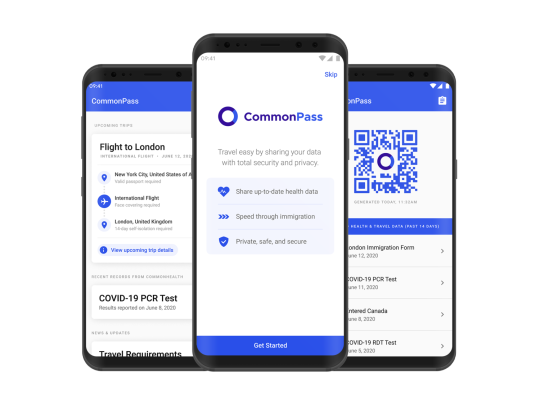Text
Blockchain & Alternative Energy
As society has become more environmentally conscious, people’s personal contribution to carbon emissions has shifted into the priorities of many. It is very important that we as a whole are able to reduce the amount of carbon emissions that we produce, and hopefully get that down to zero in the near future to protect our planet against pollution. One of the largest pollutants comes from the way that we source our energy, that being fossil fuels, but what if there was a way that we as consumers could choose where we get the energy we personally use from.

Blockchain has recently been integrated into the energy industry, allowing a system to be built that can accurately track the source of energy through the grid. This technology can track the specific unit of energy all the way from its source to one’s cell phone. This of course can encourage people to choose alternative energy as their preferred source of energy if they have access to a grid where blockchain technology is implemented and the option is given to the consumer.
Most of this implementation will come through regulation, as agreements between countries are enforcing the use of renewable energy, and these features will keep all involved parties accountable for their promises, as there is no way to manipulate the system.
Successful tests of this have already been completed. For instance, in Estonia, a smart-grid with blockchain technology was created called “WePower”. Energy providers on this grid willingly provide real-time data on their energy production, such as the method of production and the current market price for this energy. This transparency creates a more efficient and competitive market that will benefit the consumer. Although this is probably negatively affecting the energy providers, those who do not jump on board will be left behind when it is the new normal. The blockchain technology ensures that all of the data is accurate and the entire process is transparent to all parties involved.
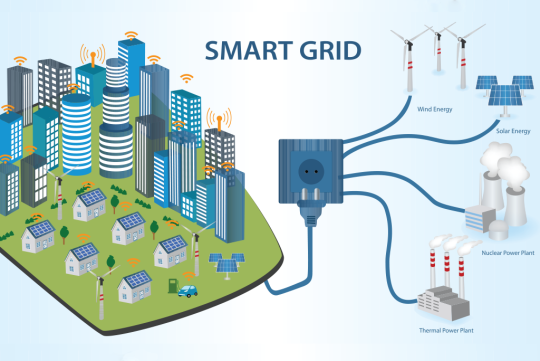
As the CEO of WePower has stated, the majority of smaller companies and individuals do not currently have a way of purchasing green energy. This is negatively impacting these consumers for multiple reasons, as the cost of renewable energy has decreased significantly in recent years and the motivation to go green has increased. If consumers are able to pick and choose the energy they purchase, it should help promote the growth of renewable energy and the decline of fossil fuels, accelerating the timeline in which our society is able to eliminate our carbon emissions.

Although on the surface an initiative like this seems to have no drawbacks, significant investment is required in order to get systems like these up and running. One of the largest hurdles that needs to be cleared is getting each consumer up to date on the required hardware necessary to be incorporated into the smart-grid. Smart meters for both gas and electric need to be installed in order for the consumer to be able to effectively route their desired energy into their homes and businesses. It is estimated that in order to build and maintain such a system for the entirety of Europe it would require an annual investment of 200 billion Euros. In the United States it would require $2 trillion of electricity network upgrades to launch smart grids across the entire country for all Americans.
This technology and its implementation is very exciting, not only for the wallets of the consumer, but also for their choice to reduce their carbon footprint and impact on global warming. Blockchain has an infinite amount of potential implementations to benefit business and society, but in this case it can also benefit our planet and generations to come. However, in order to make this a reality there will have to be incentives for those large corporations to make the significant investments that will be required in order to build and maintain these networks connecting consumers with power providers. Unfortunately, there doesn’t seem to be enough motivation yet, as large power providers will not make as much money if consumers are able to use this system to select a cheaper source of energy, and therefore are likely against such developments. In order for this to come to fruition, governments will have to pass laws that require the use of green energy as well as transparent data for the consumers of this energy.
Sources:
https://www.sciencedirect.com/science/article/pii/S1364032118307184
https://www.forbes.com/sites/jamesellsmoor/2019/04/27/blockchain-is-the-next-big-thing-for-renewable-energy/?sh=1aa23a7d48c1
7 notes
·
View notes
Text
Emerging Tech x Climate Conscious Consumers / By Divya Jha
Did you know that it takes 2,700 liters to produce the cotton needed to make a single t-shirt? Or that producing a single pair of denim jeans takes enough water that a human drinks in ten years? The $3.5 trillion clothing industry produces 20% of the global water waste, 10% global carbon emissions and deposits 20 billion tons of waste into landfills every year? That’s more than the emissions by all international flights and maritime shipping combined! At its current rate, the apparel industry will produce more than one-fourth of the world’s carbon footprint by 2050. Consumers are gradually getting more conscious about the environmental impact of their fashion purchases. On the other hand, brands are also taking note of the neo climate conscious consumer. Consumers are steadily accepting sustainable fabrics, upcycled clothing and organic materials that reduce waste.
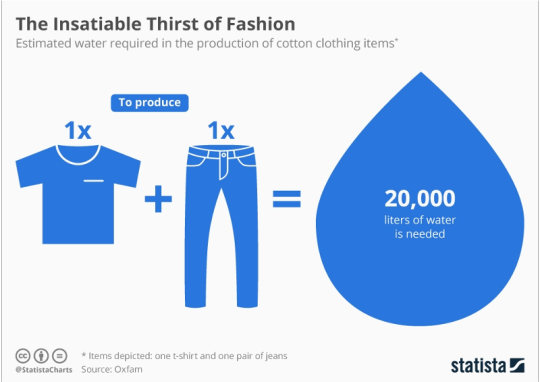
Brands like Everlane and Adidas have released lines of clothing made from recycled plastic bottles and other reused materials. In fact, Adidas doubled its number of shoes made from recycled waste this year. Zara and H&M have pledged to only use organic, sustainable or recycled fabrics in its clothing by 2025 and 2030 respectively. In a nod to the ethical consumer, Stella McCartney became the first designer to launch the world’s first faux fur made using plant based ingredients.
According to Porter Novelli, 90% of Gen Z consumers believe companies have a responsibility to not only highlight environmental issues but actively work to overcome them. However, with 45% of Gen Z shoppers likely to seek additional information on a product or company before making a purchase, it’s important to increase transparency in the apparel industry’s supply chain process. In the fashion world a massive ton of clothing gets trashed before it is even sold - this could be due to faulty manufacturing, not meeting standards, order cancellations or even errors in the supply chain. That’s another reason to increase transparency in the supply chain. Since consumers increasingly want to see how truly brands are committed to sustainability, some companies are using blockchain technology to create an online public ledger that generates a permanent and unchangeable record of transactions. So users can track the journey of the item, from the production of the raw material to the shop floor, simply by scanning the item's QR code on an app. Blockchain can be effective in securing transactions but can be limited in performance, scalability and confidentiality.

Some clothing companies are using a fairly disruptive innovation - 3D virtual sampling - to decrease product development time. In the past, physical samples were required in the design, manufacturing and selling lifecycle. Oftentimes twenty or more such samples were necessary for designers and retailers to have an accurate representation of the final product. Tommy Hilfiger will only use 3D design to create, develop and sell samples from its Spring 2022 apparel collections onward. This reduction in waste and decrease in production time will bring huge cost advantages to the company.
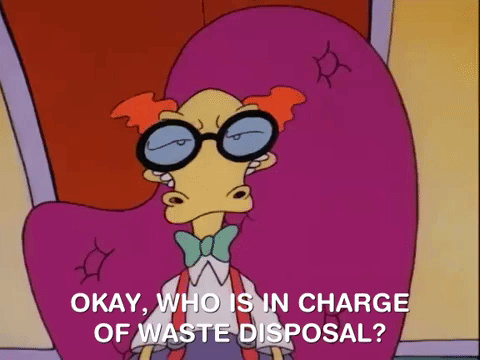
To address the concerns around labor conditions and waste caused due to human errors in the supply chain, companies are using automated manufacturing technologies such as industrial robots to assemble products. Softwear Automation’s robot was developed at Georgia Tech’s Advanced Technology Development Center. Their sewing bots or “sewbots” have vacuum-powered grips that feed fabric into a sewing machine, adjusting it accordingly using machine vision. Fashion for Good, a global initiative to make fashion more sustainable, estimates that Softwear Automation’s sewbots can help lower emissions by around 10% by creating products closer to consumers and reducing material waste.
While I agree that consumers are gradually becoming aware and mindful of sustainability in fashion and clothing, it is still not widespread enough. Changing buying patterns take time, but with positive influence and active conversation, it can be accelerated. I genuinely feel that more consumers need to pay attention to how their clothing is sourced, what happens when you dispose or throw away clothes and most importantly how the incineration of certain fabrics and chemicals leaves our planet worse off. To start off, given how active Gen Z is on social media, I think more companies should use social channels online to highlight how new technologies can be put to use to curb our carbon footprint.

--
Sources:
https://3dlook.me/blog/7-emerging-technologies-for-sustainable-fashion-production-in-2020/
https://www.forbes.com/sites/blakemorgan/2020/02/24/11-fashion-companies-leading-the-way-in-sustainability/?sh=58733ce56dba
https://www.whichplm.com/3d-virtual-sampling-evolution-or-revolution/
https://3dlook.me/blog/sustainability-inclusivity-and-traceability-a-fashion-industry-fit-for-gen-z/
3 notes
·
View notes
Text
A Digital Holiday Season By Kristen Sauer
It’s (almost) the Most Wonderful Time of the Year! With the holiday season comes the excitement and joy spread by both kids and adults who are getting into the spirit that this time of year brings. But with the way that most of this year has gone thus far, it is looking like this holiday season will have to be spent differently. And in order to do so, that means the holiday season must go virtual; a problem that people all over the world are facing together. The question now remains, how will this happen on a virtual level to still accomplish the same feelings that come during normal times?
In most years, the highlight for kids at Christmastime is getting to go visit with Santa and telling him what they are asking for that year. Whether it be at the mall or a local pancake breakfast, these usually mean large crowds and no social distancing. The famous Edinburgh, Scotland Christmas Market is going to be done online. As part of this, kids will have the opportunity to hear from Santa who will read a story nightly. It might not be the same as an in person visit, but it will allow children to still feel some of the typical holiday magic that usually lives in these experiences. This online market will also have the local venders there that usually are in person as a way to increase their sales and make a little money back that they lost during the hard times this year. I think that through keeping traditions like this one going, even on a virtual level will keep up the joy this season brings, while still bringing people together, just in a different way.

In Ireland, families can log on to Zoom together where they can have a 10 minute conversation with Santa, without needing to wait in line as they usually would. These calls are private, so families are being charged to participate in this experience. It would cost 35 euros for this meet and greet with Santa. All parents would have to do is fill out a questionnaire ahead of time to make the experience specific to them. I think this is an interesting shift when compared to the meeting Santa at the mall or other locations in the past. This is now a more personal experience and gives kids the feeling that they are getting a unique visit from this special friend, which might not have been as personable in the past, since the underlying main focus of trying to get a family picture could overtake the point of a child getting to talk with Santa.
Macy’s, one of the leading department stores known for their holiday spirit, is having to make their long standing tradition go online this year, too. At a time where these stores need more than ever to draw people in to shop, they are also having to make these difficult decisions to turn aspects of the holiday season online, which could prevent people from shopping with them. I hate that a store like Macy’s has to end a tradition that has gone on for such a long time, but it would be worse if they were still to hold in person events like these and risk employees and customers getting sick from large amounts of people there or if there was no distancing. The “Macy’s Santaland at Home”, what Macy’s refers to their Christmas festivities as, will feature some of their standard in person activities that they usually have in store, like the writing letters to Santa to benefit the Make-a-Wish Foundation. This is a very interactive experience and will allow for children to meet with Santa, although he will be prerecord, just as they would in the past. I think that being able to adapt to these ever changing times and keeping up with the change in demand is what is going to spread these companies apart and might help them in the long run to remain open, even when COVID slips away.

Although there is so much more to the holiday season than getting to meet with Santa or shop at the malls, it is nonetheless an important holiday tradition that children look forward to each year. Even though this year does look a little different, bringing together these age old traditions for children is going to help make what is going on in the world seem a little less dark. Spreading holiday light through the eyes of an innocent child, might make everyone a little more joyful themselves.
Sources
https://www.heraldscotland.com/news/18861384.digital-christmas-key-worker-santa-heart-new-digital-festival/
http://www.edinburghschristmas.com/
https://www.cnbc.com/2020/11/05/mall-santas-to-use-igloos-and-virtual-visits-as-covid-cases-surge.html
https://www.macys.com/social/santa-land/
https://www.timesnownews.com/the-buzz/article/santa-claus-to-go-digital-father-christmas-will-stay-home-this-year-and-make-zoom-calls-to-kids-from-north-pole/671625
6 notes
·
View notes
Text
Are Virtual Influencers The Next Big Thing? by Katy Lee
In recent years, K-pop has gained worldwide recognition. One of the unique traits of K-pop is that they always tend to be in groups. Within the industry, almost a new group debuts every week, so when I heard another girl group was making a debut I didn’t think much about it. Until I heard their concept, something unique and has never been done within the Korean Music industry, virtual members. I was always used to real people/ members being part of a K-pop group, however, in a recent announcement recently made by South Korea’s top entertainment company, SM Entertainment, they are planning to debut a new venture group that mixes humans with virtual members. Yes, virtual members that are AIs. The K-pop group “aespa” is set to debut in the next week to turn a new page in the chapter of Kpop. The group’s name, “aespa”, is derived from the words “avatar,” “experience,” and “aspect.” It has been said that the real-life members of aespa will continue real-world promotions like other Kpop stars going on concerts and live performances. Within the virtual world, their avatars will engage with fans in new and unique ways. The concept draws inspiration from several musical performances within video games like Fortnite and Roblox. The founder of SM Entertainment, Lee Soo Man said “the avatar members have AI brains that allow for them to converse and to support the real members, even befriending them, sharing information, as well as going back and forth from one world to another.”

We’ve seen the rise of virtual influencers and pop-stars like Lil Miquela and Japan’s Hatsune Miku. But what if real-life and virtual idols came together in one K-pop group? When I first heard this, I had mixed emotions. Not only is this a new concept to me but I was curious to see how successful it will actually be. It’s pretty common to see computer graphics and technology being utilized for music videos and virtual influencers/ pop-stars is not a totally new concept. We’ve seen artists like Travis Scott, Marshmello, and others are already exploiting their digital selves for a massive gain. The Travis Scott Fortnite concert event was one of the most-watched in-game concerts ever. However, seeing a combination of the virtual and real-world is unheard of and a bit creepy for me.


The purpose of creating these virtual stars is to solve problems and perform actions that real pop-stars cannot achieve. Real celebrities deals with lots of scandals, but avatars won’t have that problem and fans can essentially interact with them anywhere and anytime they want. The avatars are capable of doing things you cannot directly do with your favorite celebrity. Imagine an avatar of your favorite celebrity being created and being together with him/her, next to you. Kind of creepy or uniquely attractive? This news had stirred quite a controversy across K-pop fans. They find the idea of fans “owning” their idols problematic, especially when “aespa” is made up of young women. Others also think virtual idols will only make fans, some dangerously obsessive, more far removed from reality. Fans dislike the ambiguity of mixing a fake and real world together. Many people think that this will further perpetuate “sasaeng” fan behaviors. A term widely used in Korea to describe obsessive fans who stalk or engage in behaviors that invade an idol's privacy. It is not uncommon for sasaengs fans to go through extreme measures to see their idols in Korea, which is why “aespa’s” concept it worrying many people.
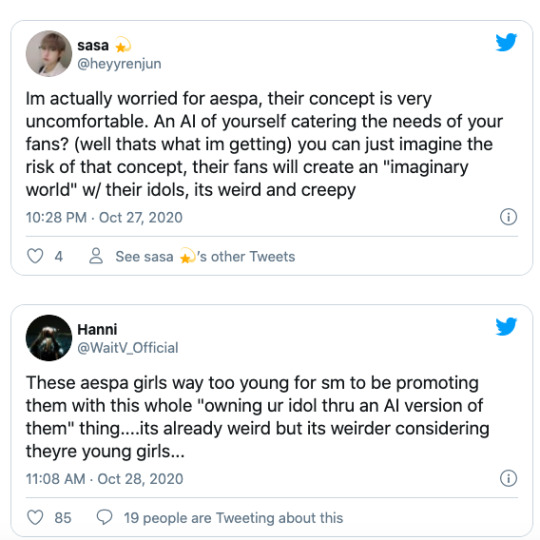
While there are many factors to be worried about, I can see how this concept can be successful. Given that virtual idols have proven to be popular and it has been done before. For example, Hatsune Miku, a character developed by computer programs and has appeared on billboards, in TV commercials, and gave sold-out concerts to fans all over the world. The main reason for Hatsune Miku's success is that at some point she stopped being looked at as a software program and started being treated as a legitimate pop star. Miku's virtual status has allowed her to easily move into forms of media often ignored by real-world idols. If done properly, this can be the case for “asepa” as well. SM Entertainment might change the future for not only K-pop but other countries. We have seen technology being gradually integrated into the music industry as a whole especially with the pandemic and more virtual events, “aespa’s” concept might not be completely bizarre. I’m curious to see the results of this launch and whether it’ll be a it a miss. Should we be expecting more artists to opt to become an avatar whether it may be in games, music or another platform entirely?
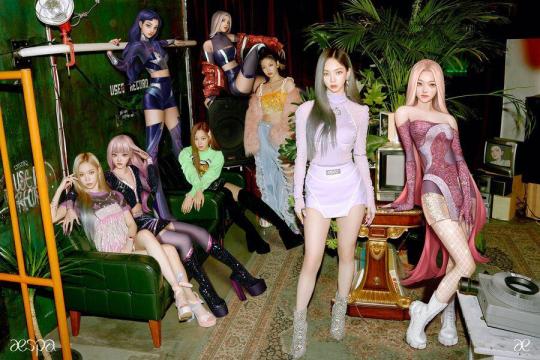
Sources:
https://reputationtoday.in/virtual-influencers-the-next-big-thing/
https://www.digitalmusicnews.com/2020/10/29/k-pop-group-aespa-introduction/
https://www.vice.com/en/article/bvxxgd/aespa-kpop-music-girl-group-virtual-sm
https://kotaku.com/why-hatsune-miku-is-the-worlds-most-popular-virtual-ido-5936200#:~:text=With%20Miku's%20Vocaloid%202%20in,primed%20for%20her%20big%20break.&text=And%20because%20of%20the%20ease,covers%20of%20popular%20Japanese%20songs.
https://www.huffingtonpost.in/entry/aespa-ai-lee-sooman-sm-entertainment_in_5f9a4b71c5b6a4a2dc823ae6
https://www.soompi.com/article/1433733wpp/watch-sm-drops-mysterious-teaser-launches-twitter-account-for-something-called-aespa
https://futurism.com/the-byte/new-k-pop-band-include-cgi-performer
4 notes
·
View notes
Text
It’s Time for Brands to Embrace Activism -By Chad Valpey
2020 has perhaps been the most eventful and political year of our time for many of us. Worldwide protests for justice, devastating environmental events, a widespread virus, and a notorious U.S. election have plagued our lives and our social media feeds so far this year. People around the country have also called for change like never before, marching for BLM, demanding better environmental legislation after deadly CA wildfires, and even electing our new president. During such turbulent times, how can brands safely and effectively navigate their advertising campaigns? Should brands be mentioning these issues at all? As it turns out, avoiding speaking on important events in a climate of increasingly engaged and frustrated consumers may be hurting brands.

Consumer beliefs and what they care about have changed, especially due to new generations like millennials and Gen-Z. Now, especially with the rise of social media, brands have to be more careful than ever before with what they do and say. In a recent 2019 study, 70% of consumers said it is important for brands to take some kind of stand on important issues, up from 58% in 2017. Majority of these consumers even noted that they felt brands have more power to address and solve major issues than the government. Consumers have strong opinions about brands, and they aren’t afraid to act on them. 64% of worldwide consumers will make a purchasing decision based on a brand’s social or political position, according to the 2018 Edelman Earned Brand study. These statistics show that consumers have politics and social issues at the forefront of their minds, even when shopping or seeing ads, because they recognize how brands are related to such issues.
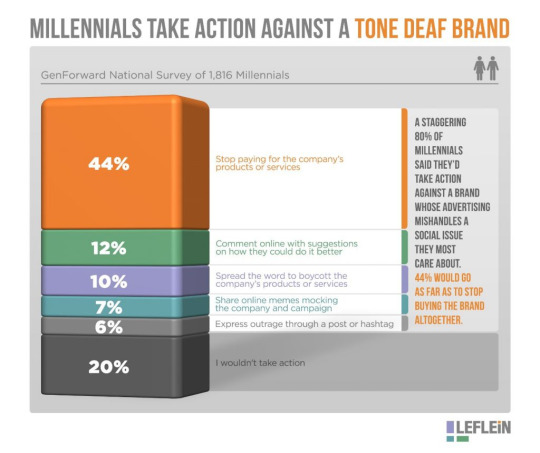
With so many consumers caring about what brands do, it is crucial for a brands long-term reputation to say something when it matters. A brand's actions can directly affect its employees, customers, and the environment either in significantly negative and positive ways. In recent decades, consumers have become smarter and are watching brands more closely. Boycotts of even the largest brands have become normal, as consumers realize that certain brands are hurting society in impactful ways. People want brands to speak up because they need to know whether or not a company they are giving money to cares about important issues that affect them. In a country of increasing diversity, awareness, and activism, what might a brand's silence on important race, women's rights, immigrant, and LGBTQ+ issues (and many more) say to its consumers? When it comes to morality and human rights in particular, more and more consumers are accepting the notion that silence is complicity, and complicity is bad.
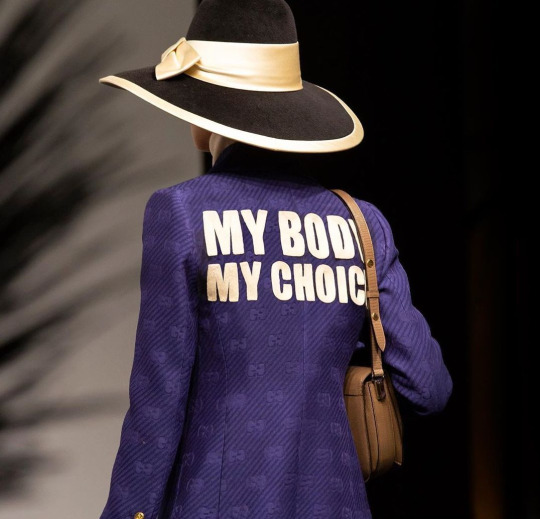
The challenge for marketers is figuring out how, when, and through which channels it is appropriate to speak out. First, a brand must determine if it is the right time to speak out, and if their comments will be relevant. I would argue that in today’s political climate, it is almost always relevant to speak out. With so much going on, particularly this year, brands have many opportunities to speak out about important issues, and tie these issues back to their marketing strategies. If a brand claims to stand for and support its black employees and customers, there isn’t a reason to stay silent during the ongoing BLM movement. If a brand cares about the environment, they should be taking actions to help our earth. There are countless examples of brands who have used activism successfully both to their and society's advantage. A prime example is Gucci, who have used political statements to both promote awareness and increase brand value through an increase in sales among millennial consumers. By donating to the March-for-our-lives campaign, and writing ‘My body, my choice” on clothing during a fashion show, Gucci increased their 2018 sales as more millennials began purchasing after noticing their continued activism efforts. Beyond increasing sales, actions like these from a major global company can bring new awareness and real change.
A company must also speak out in a way that feels authentic and true to their values. If a brand claims to stand for equality and justice, then speaking out against current injustices should feel genuine if done correctly. Finally, a firm must decide through what channel to speak out. Only 47% of consumers said that they want brands to share political values through social media, so a video advertisement on T.V. may be a better approach than a post on Facebook.

These stances, if done right and through the right channels, can be incredibly positive for a company. When Nike released its infamous ad featuring Colin Kaepernick in 2018, it quickly went viral. Although many conservative-leaning customers boycotted Nike for supporting Colin and his protest against police brutality, Nike still saw a 6 billion dollar boost in brand value and a 31% increase in sales just one year after the ad. The reason? Nike’s target audience and loyal customers resonated with the ads message and appreciated Nike’s stance on an important issue happening within the NFL and beyond. As a result, Nike was able to spread positive awareness internationally for an important issue, and increase their own brand value at the same time.

As political and social issues continue to increase in the coming years, consumers will continue to watch brands. We have seen more and more people stand up for what is right this year, and speak about issues that only are getting worse as time moves on. I think one sentence from an article I read summed up best what the future could look like for brand activism: “Companies who are afraid to speak because they’re trying to target everyone, alienate everyone by standing for nothing.” Not only is it the right thing to do to speak out, it’s becoming increasingly important as consumers begin to value a brand’s values more and more.
Sources:
http://overit.com/blog/brand-politics
https://www.inc.com/amanda-pressner-kreuser/should-your-business-take-a-political-stance-here-are-3-brands-that-did-and-how-their-customers-reacted.html
https://insight.kellogg.northwestern.edu/article/boycott-brands-era-easy-outrage
https://www.businessinsider.com/cmos-how-brands-should-participate-in-social-political-issues-2019-8
https://www.impactplus.com/blog/should-brands-get-political
https://hbr.org/2020/02/how-do-consumers-feel-when-companies-get-political
https://www.marketwatch.com/story/more-people-see-value-and-quality-in-a-brands-politics-not-products-as-facebook-and-other-companies-are-learning-2020-07-01
https://www.mediapost.com/publications/article/342996/survey-consumers-want-brands-to-take-political-st.html
https://www.fastcompany.com/90399316/one-year-later-what-did-we-learn-from-nikes-blockbuster-colin-kaepernick-ad
https://veracontent.com/mix/why-your-brand-shouldnt-stay-silent-on-social-issues/
4 notes
·
View notes
Text
The Success of Gamification in Different Industries
Ivan Ip Gamification was termed by Nick Pelling in 2002 as “Applying game-like accelerated user interface design to make electronic transactions both enjoyable and fast.” Today the most commonly used definition is “the application of typical elements of game playing (such as point scoring and competition) to other areas of activity.” We can see that the definition hasn’t changed over the past 18 years and revolves around integrating a gaming experience into a process or activity. Gamification is successful because it entices users to complete specific tasks. Users enjoy receiving content or even delivering content because there is a psychological drive behind games. Games satisfy a basic need for self-fulfillment and they motivate users who become invested in the activity. By understanding this psychological drive behind the success of gamification, companies and organizations are able to utilize gamification to increase user retention, user acquisition, brand loyalty, and awareness, while developing the users’ sense of developmental growth and accomplishment. Through gamification, companies are able to gather more accurate user-data which also allows companies to make more high-quality insights.

Today we can see gamification in different fields and industries such as education, business, stock trading, and exercise. In exchange for receiving content, users can earn experience, certificates, badges, and even awards! For example, companies such as ClassDojo, Brainscape, and FieldXperience focus on gamifying eLearning. It now represents a $200 billion industry. This industry continues to grow and has only been strengthened by the COVID-19 pandemic. Schools will use gamification to enhance engagement, interactiveness, and memory retention while companies utilize the technology to train their employees more effectively. As students continue to learn from home, educational institutions are investing in technology to deliver content. According to Zion Market Research, the massive open online course market (MOOC) which are free online learning platforms for students worldwide will grow from a $3.61 billion industry in 2018 to a $25.33 billion industry by 2025.
Not only can businesses utilize gamification to train their employees, but they can also use it to increase engagement and provide unique experiences. For example, Starbucks utilizes a mobile application for its loyalty program. The Starbucks Rewards app is very successful because it allows customers to earn points whenever they make purchases. They can then trade in these points for free snacks, cups, and coffees. Rather than utilizing traditional ink-on-paper loyalty cards, which often get forgotten or misplaced, an app allows customers to engage with Starbucks as long as they have their mobile device. Not only does the app encourage loyalty to the company, but Starbucks now has a way to reach out to their customers. Starbucks can send out points to customers for completing surveys, checking-in to a location, or even share their most recent purchase. In 2019, users who utilize Starbuck’s membership program and app accounted for about 40% of sales at the company’s US stores. Now other companies such as Chipotle and Burger King are creating their own mobile loyalty programs.
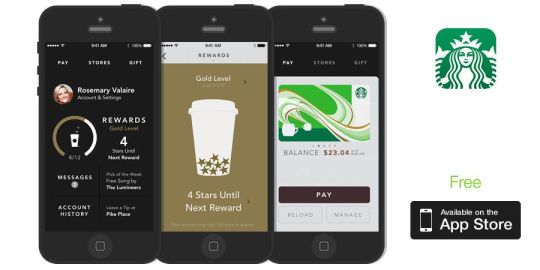
Gamification is unsurprisingly also used in the exercise and lifestyle industry. For example, Nike understands that for many people, lack of motivation is a huge obstacle for consistent and effective training. Without a training partner, personal trainer, or other forms of encouragement, it is easy for many people to give up on exercising and thus fall away from healthy habits. However, Nike utilizes gamification in its apps such as NikeRun and NikeFuel to increase its users’ engagement and interactions with the company. By utilizing games to motivate their audience, Nike is able to create consistent users through validation, completion, and rewards. NikeFuel allows users to share their fitness achievements online with their friends and families. They can also compete with others and to encourage healthy habits and consistent exercises. By creating a community for individuals, Nike is able to help each user celebrate their small and unique victories which encourages them to keep going and “Just Do It.” By increasing users’ confidence in their abilities, Nike is also able to increase engagement within the app and company.

I definitely believe that gamification will be a critical way for companies, businesses, and schools to engage users, students, employees, and clients. This shift towards online learning and gamification will only speed up as the COVID-19 pandemic continues to limit in-person activities. As users become more technologically savvy, I can see how many people would prefer to utilize their mobile devices to engage and receive content. I can see this industry continuing to grow especially when combined with other technologies such as augmented reality (AR). As with many forms of technology, critics will argue that gamification will lead to less social interactions. However, I believe that gamification should be utilized since it allows different industries and processes to become more efficient and effective.
https://www.globenewswire.com/news-release/2019/03/14/1752909/0/en/Global-Massive-Open-Online-Course-Market-Will-Reach-USD-25-33-Billion-By-2025-Zion-Market-Research.html
https://elearningindustry.com/important-statistics-about-the-elearning-market-for-2013-infographic
https://edition.cnn.com/2019/03/19/business/starbucks-new-rewards-program/index.html
2 notes
·
View notes
Text
How fast can a hyperloop go if a hyperloop hyperloops? / Crystal Chen
Just this past Sunday in the Las Vegas desert, two individuals stepped into a two-person pod, propelled down a 1,640-foot track at roughly 100 mph, and came out with a historic achievement: it was the first time a hyperloop pod had held humans as it traveled down a strip of track. And it was done with confidence, as Virgin Hyperloop, who has been working on this since 2013, put both their chief technology officer and head of passenger experience inside the vessel.

Now you might be wondering what hyperloop technology is. First seriously considered in 2013 by Elon Musk, a Hyperloop is an innovative transportation system that theoretically could propel aerodynamic aluminum capsules down a nearly airless tub at speeds of up to 700+ mph using magnetic levitation technology. That means traveling from New York City to Washington, D.C. could be cut down from one hour on an airplane or 4 hours in a car to 30 minutes in a hyperloop system. Since Musk’s blog post, several companies have entered the space to work on this technology, from both a research and development standpoint and a federal regulation standpoint.
One of the companies is Virgin Hyperloop, a company launched in 2014 and the company that successfully deployed this trip. Virgin Hyperloop initially came out strong with nearly tens of millions of dollars in funding. But as is with all emerging technology, estimated funds are often only a fraction of the actual cost for researching and developing new technology to be fit for genuine human use. As a result, Virgin Hyperloop was strapped for cash for some time, before securing a $50 million investment. Additionally, in 2019, Virgin Hyperloop raised $172 million in new funding.
After a turbulent few years and subsequent successful fundraising, Virgin Hyperloop was able to bring themselves back on track, figuratively and literally. The pod, dubbed the Experimental Pod-2 (XP-2), only reached 100 mph on its first trip with humans, a number far below the predicted 670 mph Virgin Hyperloop has for this type of technology. But it certainly can be attributed to the limited amount of track VH has in the desert. With only 500 meters of track to work with, reaching 100 mph certainly is a feat. To put it into more easily digestible context, those numbers translates to the XP-2 traveling 48 meters per second, completing the trip in about 10 seconds.

With Virgin Hyperloop advancing their hyperloop system towards reality, they recently announced a plan to build a $500 million certification center in West Virginia to advance its vision of future high-speed transportation. The possibility to extend their track to add the additional 2,000 meters could be monumental in hitting the theoretical maximum speed of 700 mph.
As with emerging technology often having unpredictable cash and capital requirements, there are also federal regulation hoops to jump through. For a hyperloop system in America, these companies would need to follow any regulations from the U.S. Department of Transportation (DOT). Because there exists a lag between emerging technology and government regulation, federal regulations are often outdated. The biggest reason why a lag exists is due to DOT’s main policy concern of passenger safety. DOT cannot approve every new type or modification on transportation without conducting a full-faith in-depth research analysis, which often takes time as the technology itself develops, and even if the technology itself is already fully developed. And hyperloop technology is a perfect example of why a lag would exist: an unknown technology meant to transport cargo or people that until this past weekend, had never held a human.
However, U.S. DOT has been trying to acknowledge and better help tackle these gaps. In 2019, they launched a Non-Traditional and Emerging Transportation Technology (NETT) Council, which was tasked with identifying and resolving jurisdictional and regulatory gaps that may impeded the deployment of new transportation technology. A year later, U.S. DOT released a policy document titled Pathways to the Future of Technology, which provided a framework for regulating new transportation technologies, among them the hyperloop.

While I keep referring to the hyperloop as an emerging technology, it’s important to note that there is another train in service that utilizes the same base technology of magnetic levitation. The Shanghai Transrapid, launched in 2004, services a 18.95 mile long track, with trips taking only seven minutes. It’s the fastest high-speed train in commercial operation, hitting speeds of 267.8 mph. However, it’s the only one and after its inception, China opted to continue building traditional high-speed rail technology instead of maglev, which may indicate it wasn’t worth the investment in the early 2000s.
Now that we are close to 2021 and Virgin Hyperloop has successfully launched a Hyperloop pod with humans inside it, it might be worth keeping an eye on the industry. However, with hyperloop still in its initial testing stages, who knows when we will realistically see Hyperloop in commercial operation? Touted as a technology that seems right around the corner, it definitely seems like the corner is going to be a long longer than a step away and for now, we’ll have to strap on our seatbelts not for a 30 minute hyperloop ride from NYC to D.C., but a 4 hour car ride that seems extremely long in comparison.
Sources:
https://www.entrepreneur.com/article/359390
https://www.theverge.com/2020/11/8/21553014/virgin-hyperloop-first-human-test-speed-pod-tube
https://www.transportation.gov/briefing-room/us-transportation-secretary-chao-releases-pathways-future-transportation
https://www.theverge.com/2020/10/8/21507532/virgin-hyperloop-one-certification-center-west-virginia
https://www.popularmechanics.com/technology/infrastructure/a34630407/virgin-hyperloop-first-manned-trip/
https://www.maglev.net/worlds-fastest-high-speed-trains-in-commercial-operation
https://www.freightwaves.com/news/2017/10/19/regulations-could-slow-down-hyperloop
https://www.hsrail.org/maglev-hyperloop
3 notes
·
View notes
Text
Netflix’s The Social Dilemma: Eye Opening to Some, Manipulating and Misleading to Others by Jess Danylchuk
You’d have to be living under a rock be surprised by the simple fact that scrolling on some form of social media has grown to become a daily (sometimes hourly) activity for the majority of society, especially among groups of people our age. What social media has also become, whether we’ve acknowledged it yet or not, is an addictive and sometimes creepy stream of platforms that we often love to hate. A few weeks ago our class had the opportunity to hear an individual presentation on what it is that makes social media so addictive and I’m sure many of us have had our own personal experiences relating to the creep factor associated with certain targeted advertisements or recommendations. While these aspects of scrolling through Facebook or Twitter don’t always seem to be predatorial on the surface, there are several theories suggesting that social media companies specifically design their apps to adversely affect users’ lives.

In the recent Netflix documentary, “The Social Dilemma,” director Jeff Orlowski doesn’t hold back his exploration into the dangerous ways social networking is affecting human psychology. The premise of the documentary-drama as a whole is essentially giving the audience an inside look at how the Internet’s most popular products work on a basic Machiavellian-like business model of tracking the behavior of users to keep them engaged on the screen and instigate an addiction in a vicious cycle. Orlowski interviews many former Silicon Valley engineers who designed various successful social media platforms, as well as converses with other technology and psychology experts who weigh-in their thoughts on what the manipulation of social media and its relevant companies on the human brain means for society in general.
youtube
There were several key insights “The Social Dilemma” presented, including helping viewers understand that social media is truly designed to be as addictive as it is. Neuroscientists have compared social media interaction to an injection of dopamine into the human body and found that the constant and instant stream of retweets, likes, and shares from social media sites affect the brain’s reward area and triggers identical chemical reactions to those of other drugs like cocaine. Experts in the doc also reiterate the findings that self-disclosure on social networking sites lights up the same parts of the brain that ignite when taking addictive substances. FOMO and withdrawal symptoms have also been found to be present in many people when their social media use is restricted for a given period of time.
While the topic of the dangers of socials is not one new to discussion by any means, this documentary furthers the conversation around why we should fear socials, especially at a time where the world’s atmosphere is highly divisive and politically polarized. However, as many highlights as there were in the film that uncovered the darker sides of society’s (arguably) favorite form of entertainment, not everyone is praising the how the production team presented social media as a threat to humanity and the ever-developing society we all live in.

The main criticism worth noting is the fact that while the quite unsettling revelations about the damage companies like Google, Twitter, and Facebook have done to society have been called “eye-opening” to those now slamming social media, what these people fail to acknowledge is that there are no solutions to the industry’s problems offered anywhere in the film, leaving viewers sort of in a state of panic and disgust with the current situation, yet nowhere to turn to fix the issue. The recommendations at the finale of the doc don’t expand much further than ordinary “self-help” suggestions like turning off notifications, fact-checking, and ignoring what the recommendation algorithms suggests – the latter of which is pretty ironic, considering most viewers of the film probably pressed “play” because of this very algorithm. It’s also interesting to consider how the problem itself is a cause of the tech industry and its big name players, but the burden of dealing with its affects moving forward is placed entirely on us as users. This doesn’t exactly seem like a fair situation to me.
Sources:
https://www.nytimes.com/2020/09/09/movies/the-social-dilemma-review.html
https://www.cinemablend.com/news/2555346/what-is-the-social-dilemma-things-to-know-about-the-netflix-documentary-before-you-watch
https://www.cnbc.com/2020/09/21/netflix-movie-the-social-dilemma-slams-social-media-review.html
https://ecowarriorprincess.net/2020/10/key-takeaways-the-social-dilemma-documentary-netflix/
2 notes
·
View notes
Text
Tik Tok is Revolutionizing the Music Industry | By: Alice Yang
Tik Tok is known to have brought about countless viral trends from funny challenges, meme-able videos, and of course, the fifteen second dances that have swept the world. Something a little less obvious is its huge impact on the music industry, and how it has completely changed it in terms of marketing and types of music. It has also revolutionized the way that users discover music.
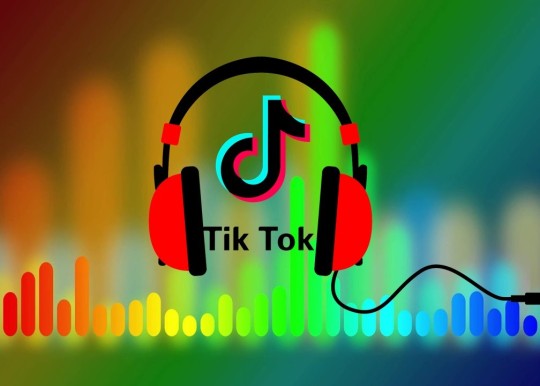
For artists of any kind, uploading audio can drastically increase their popularity and allow users to discover sounds that they would never really hear otherwise if it wasn’t for Tik Tok’s For You Page. The great thing about this For You Page is that users do not even have to follow anyone for a plethora of videos to start popping up on their page. This allows artists from all different genres and levels of popularity to reach people they may never have reached before. Thus, the audio tracks can include anything from major hits to independent artists or to just absurd audio clips that users can make entertaining videos to. Once the audio is uploaded, users can use this audio in the back of their videos. Many trends have come from specific audios, from dances to funny challenges, that feature a specific audio in the background. When these trends become viral, users will hear this audio over and over again and automatically know the song and associate it with the particular Tik Tok trend. An example of this is Doja Cat’s “Say So” song that has completely blown up all over Tik Tok and thus around the world. As users used this sound to do the famous dance associated with it, it became a huge part of Tik Tok. Personally for me, I know I saw this dance at least several times on my For You Page every time I opened the app. I would automatically associate this song with the dance and even added this song to my Spotify playlist since I thought it was so catchy and fun. Doja Cat started as a viral hit on Tik Tok and rose to be the number one artist in the world. In my personal experience using Tik Tok, there have been so many times where I thought a song sounded catchy while watching the videos on my For You Page, and then went to Spotify to add that song to my playlist to listen to outside of Tik Tok.

Not only is Tik Tok revolutionizing the way the users consume music, but it is also changing the way that many artists are producing and creating music. Artists are now making music that can be cut up into smaller clips solely for the sake of gaining viral status on apps such as Tik Tok. According to Billboard charts, songs have decreased in length by twenty seconds from 2013 to 2018 and continue to drop. Now, for many artists, personal creativity and expression is definitely still important however; it is also crucial to consider audiences and how best to market a song so that it can go viral. Virality has gained increasing importance for the music industry, as Tik Tok is the perfect catalyst for making particular sounds and music go viral. Many artists are focused on making loopable beats or catchy lyrics in hopes of catching the attention of users. Ariana Grande, an already very established artist, just released a new album. Her song, “positions”, is already all over my For You Page, with users creating impressive transitions and makeovers using the song in the background. As someone who doesn’t really listen to a lot of Ariana Grande, hearing these sounds over and over again has made me gain a strong liking to a lot of her music that is currently all over Tik Tok, making me go to Spotify and adding those particular songs to my playlist so that I can listen to more of it.

It’s interesting now to see that when I open my Spotify app and go to the top charts, most of the songs are all viral songs that have gained a lot of traction from Tik Tok first when users use these particular songs for trends and dances. I see Tik Tok continuing to be a major and crucial platform for music of all different genres to gain traction, for the content on Tik Tok is perfect for promoting music and sounds to a viral degree.
Sources:
https://www.imaginemediaconsulting.com/blog-all-posts/tik-tok-music-industry#:~:text=Artists%20are%20now%20making%20music,which%20is%20only%201%3A53.
https://medium.com/ipg-media-lab/what-tiktok-tells-us-about-the-future-of-music-business-1cdc8c18a2a2
https://www.rollingstone.com/pro/features/tiktok-video-app-growth-867587/
1 note
·
View note
Text
Not taking a stance is the most controversial stance - Natalie Tromer
Over the past few months, particularly as the election grew closer and tensions grew, many celebrities took stances in support of Joe Biden and Kamala Harris. Taylor Swift, Ariana Grande and Lizzo were among some of the few who mentioned Biden and Harris by name and pledged public support for the candidates to their massive platform. Even more common, though, were the vague offerings of non bipartisan political activism that encouraged their followers to vote, make voting plans, and participate in the election.
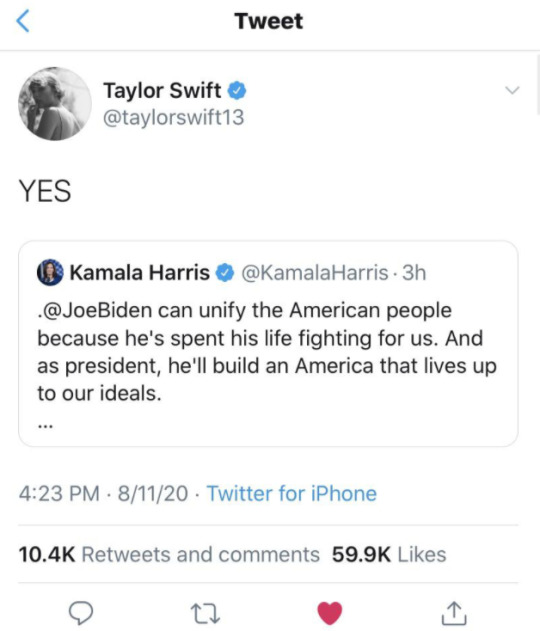
There are, however, since the announcement of Joe Biden’s victory, an alarming amount of celebrities and public figures who have celebrated his win despite the fact that they never claimed him as their candidate. Kim Kardashian, Kevin Hart, and smaller figures like fashion influencer Danielle Berenstein, are among some of the many celebrities who have since come out and celebrated the victory of “their candidate,” despite the fact that they did not use their platforms to promote him or his ideas. It is only after the victory that these figures have stepped out and publicly shared their beliefs

The post-win support seems empty to most of the celebrities’ followers, and begs the question of their intentions. This is very applicable to how we’ve spoken about brands not speaking out on issues out of turn, and making sure not to appear tone deaf or turn away any of their consumers. Not publicly endorsing a candidate prior to the outcome was “playing it safe,” but as political tensions continue to grow it becomes more and more true that perhaps not taking a stance is the most dangerous stance.
As we discussed in class this past week, often on social media those who are participating in the conversation are those who are passionate on one side or the other. It is clear that companies, like GAP this week, and celebrities, like Katy Perry this week, who take a neutral stance on such polarizing issues are criticized greatly. As the conversation around politics gets more and more polarizing, keeping quiet until victory will likely become another example of a poor choice by public figures. Politics has become more vocal every election season, and choosing to not make a statement is the most inadmissible in the public eye for celebrities and companies alike. Major celebrity news outlets like yahoo, DietPrada, and PopSugar have already posted articles “calling out” these celebrities since saturday, and I believe this hypocrisy is only more likely to begin to be called out.
0 notes
Text
The concerns of remote psychotherapy during the pandemic / Karen Wang
Virtually everyone has been affected by the coronavirus pandemic. Many industries were hard-hit leaving individuals previously working in those sectors to face unfortunate financial and personal circumstances. Even those who did not suffer financially were still burdened by the political, economic, and social changes associated with the pandemic. Persisting stressors associated with Covid-19 including self-quarantine, social distancing, unemployment, and threat of illness, have had a significant impact on the human psyche. People who otherwise did not have underlying psychological issues before the viral pandemic have begun seeking therapy to adapt to the challenges before them. To many, the virus is a life-changing crisis: 10% of the population may meet the criteria for major depressive disorder and even more for PTSD as a direct result of the environment surrounding the pandemic. As the world is experiencing a serious mental health crisis due to the impact of Covid-19, there has been an increase in demand for therapists. While the psychotherapy industry must be strong amid a global pandemic and secondary mental health epidemic, it is not perfect.

While the main objective of therapists is to connect with patients, it has paradoxically proved to be difficult due to the practice of social distancing. The psychotherapy industry must also employ technology to deliver services remotely. Video and telephone are the main communicative methods for psychotherapy delivery during the pandemic. Some psychotherapists and patients who were less adept with technology struggled at the start, but the remote delivery of psychotherapy will soon become an established routine practice. Despite growing evidence that there is little difference between delivering remote therapy and face to face therapy, in-person communication and interaction is still highly beneficial. In addition to listening, therapists must also read their patient’s body language which can be hidden in a video call. While I am glad teletherapy works for some, I hope therapists do not entirely adopt remote services post pandemic because some individuals can benefit more from in-person counseling.
Another issue affecting the psychotherapy industry is that therapists are under strain, counseling patients on trauma they are also experiencing themselves. Thousands of mental health professionals have had to adjust after a surge of demand for their services during Covid-19. With higher unemployment and changing lifestyles, some therapists have more to take on, understanding that more people are in dire need for mental health care now than before. As the pandemic became a national emergency in March, hotlines including the National Suicide Prevention Lifeline as well as the Disaster Distress Helpline received an influx of calls. Even mental health professionals and therapists face the same anxiety, uncertainty and financial troubles that their clients are addressing. They are not immune to the pandemic’s impact and have insecurities and concerns of their own. The entire world is experiencing a similar trauma. It has been a challenge for mental health workers to manage self-care while trying to provide solutions for others. Therapists are humans too. There are many advertisements online to connect people with resources on mental health, but free hotlines and private health services are more overwhelmed during this time than ever before.
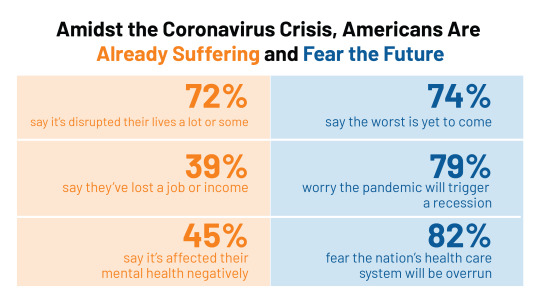
Many therapists and counselors have to also balance the demand for their services with loss of income. Even though there are more people newly seeking therapy, not everyone can afford mental health care long term. Some clients had to stop therapy after losing their jobs since the pandemic. It is unfortunate that those who received care for psychological disorders pre-pandemic no longer have the monetary means to continue. Therapy is a costly luxury that can not be afforded by many of those who need it most. Those who seek therapy in the wake of the pandemic are different than those who have always faced mental health issues. I have seen many social media posts regarding getting help over worries about the pandemic. New patients anxious over the current crisis have to realize mental health is not an easy solution. Therapy is a long term service where patients have to practice coping skills through time and to continuously meet with their providers. It seems easier to get counseling over the phone or computer screen, but how many of these people will need care after people get their working and social lives back? Going to see a therapist in an office appears a lot more serious. People who are new to mental health care might expect professionals to not have problems of their own, but these workers are not exempt from the pressures of coronavirus. These misconceptions show there may be uncertainties over the ability for these stressed patients to pay for services long term. Whether the industry can maintain the demand while still providing adequate care is still up in the air.

Psychotherapy is an essential part of the response to the Covid-19 and mental health crisis. The pandemic is a “unifying trauma” that affects people others are seeking service from. With the remote delivery of psychotherapy, there may be more access to services; however the demand might not be consistent post pandemic. Some therapists are trying to find potential clients through social media as financial strains have caused old clients to drop services. Telehealth platforms allow professionals to hold sessions online, which can connect clients to highly rated therapists no matter the location. However, I think an essential part of therapy for certain individuals is face to face interaction with a familiar provider which technology can not yet replace. Because therapists rely on their interpersonal skills and knowledge of the psyche, they need to be able to stay mentally strong themselves in order to meet growing needs.
Sources:
https://www.nbcnews.com/news/us-news/therapists-are-under-strain-covid-era-counseling-clients-trauma-they-n1230956
https://psychotherapy.psychiatryonline.org/doi/10.1176/appi.psychotherapy.20200015
https://www.goodtherapy.org/blog/why-should-i-go-to-therapy-8-signs-its-time-to-see-a-therapist-0118197
2 notes
·
View notes
Text
Snapchat: Instant image messaging app turned Sommelier? By: Shannon Foley
Snapchat first launched in 2011 as a real-time picture chatting app and has since experienced rapid growth, making it one of the most widely used social media platforms in the world. Snapchat has 360 million active users with three billion photos and videos generated everyday. Although Snapchat’s photo and video messages disappear after a few seconds, and stories expire after 24 hours, the company has proven over the past 9 years that it is not disappearing any time soon. One of the main reasons Snapchat resonated with younger audiences was rooted in concerns of their social media history getting them in trouble in their professional lives or future endeavors. People loved the simplicity of the concept and the exclusivity that came with sending private photos.
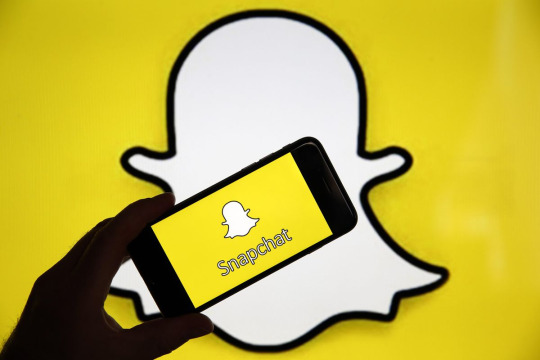
Founder Spiegel said that “Snapchat changed the perception of deleting something as bad.” The app essentially tried to model virtual conversations in the same ephemeral way that they are in real life.

Since its inception, Snapchat has evolved significantly over the years with the introduction of various features such as stories, bitmojis, snap map, augmented reality filters, and visual search functions. At its annual partner summit in June, Snapchat announced the release of additional visual search features to identify cars, plants, dog breeds, solve math problems, songs, and even products by scanning images via its camera function. Most recently, Snapchat has added the capacity to scan food and wine labels and display specific information on the products. This setting is not necessarily revolutionary, given that other food and wine specific applications already offer similar functions to show nutritional information, price rating/reviews, and tasting notes. The information on food-related labels is provided through nutrition app Yuka and the wine-labels go through the third-party app Vivino.

It was a strategically advantageous move on Snapchat’s end to partner with other applications that already specialize in food and wine and can offer accurate details and advice. This is reminiscent of their previously-established partnerships with Shazam to distinguish songs and with Amazon to look up common products. In terms of the food and wine third party apps, this is mutually beneficial. It gives brands exposure and gives Snapchat access to a range of scan options, based on credible databases, which enables users to scan a range of products to gain supplemental insight and data. This eliminates the research-intensive process Snapchat would have to undertake to collect this data. To this extent, they only have to focus on perfecting their visual search technology to ensure that its scanning and image-recognition capabilities are accurate via an easy-to-use interface. On the same note, this is an interesting way for brands to market themselves in a digitally-savvy way and simultaneously reach an extremely wide audience.

Visual search and augmented reality will continue to evolve, raising the question as to what the next stage for this technology holds. Some may project that the next logical progression would be incorporating the camera feature into glasses. However, I personally feel this is unlikely given the historical failures of so many brands to bring this goal to fruition in past years. They are very expensive and not widely adopted. Nonetheless, Snapchat seems to have a strong grasp on the complexities of image-recognition technology and seamlessly blends this with user’s daily tendencies and actions. It’s fair to assume for the most part, a majority of users perceive Snapchat as such a silly, goofy app to put filters on our faces and record comical videos of our friends. Despite this, they are a leader in social media and emerging tech and have successfully anticipated and navigated changing consumer needs to establish their presence as a social media giant today. In fact, Snapchat’s revenue reportedly increased 52% this year to $678.8 million, which is the fastest growth it has seen in three years. This is likely largely due to the increase in user screen time due to the COVID-19 pandemic. Furthermore, the company also credited the strength of its AR experiences as a critical source of revenue, “as brands sought to engage customers who were less likely to shop at retail stores because of safety concerns”. I believe that the trends and habits ingrained in consumers during quarantine will not entirely stick in the post-COVID era, but will certainly translate into their decision-making and behaviors. This means that brand marketing via Snapchat could be a very useful tool for brands to implement.
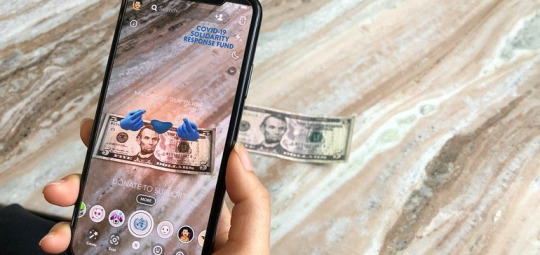
I think the incorporation of these new features is an attempt for Snapchat to remain relevant in today’s constantly evolving digital and social media landscape. For example, competing platforms such as Facebook and Instagram have released updates that seek to position them as not only a place to bolster social connections, but also function as online marketplaces of sorts. Although I think it's a stretch to conclude that people will begin shopping via Snapchat, it definitely offers interesting ways for users to engage with image recognition. This definitely aligns with Snapchat’s broader goal to add more utility to the app aside from just sharing intimate moments of one’s life and communicating quickly with friends and family.
https://www.thestreet.com/technology/history-of-snapchat
https://medium.com/ipg-media-lab/fast-forward-what-we-learned-from-the-snap-partner-summit-2020-bf769165fc81
https://www.socialmediatoday.com/news/snapchat-adds-new-barcode-scanning-capacity-for-selected-products-providin/587596/
https://wersm.com/you-can-now-scan-food-and-wine-labels-on-snapchat/
https://www.engadget.com/snapchat-scan-food-and-wine-labels-130019011.html
https://www.socialmediatoday.com/news/snapchat-adds-new-barcode-scanning-capacity-for-selected-products-providin/587596/
https://www.mobilemarketer.com/news/snap-revenue-surges-52-as-direct-response-ar-ad-offerings-pay-out-during/587423/
https://www.socialmediatoday.com/news/snapchat-adds-new-barcode-scanning-capacity-for-selected-products-providin/587596/
7 notes
·
View notes
Text
Your Cash is Worthless, the Rise of Cashless Payments and E-Commerce - Kelsey Koswick
You know how kids today think a floppy disc image is just the “save button” and have no idea that a floppy disc was an actual thing? Or that texting began with T9 (an ancient form of language) and you could only text after 9pm since that’s when it was free? Hot take but you heard it here first, physical coins and bills will be nostalgic memories and the next generation will have no clue that people would ACTUALLY use the physical objects to buy stuff.

I know this may sound far fetched but the world has been shifting to cashless/contactless/credit card free payments for a while and recent events have only poured gasoline on the cashless movement. Prior to COVID-19, U.S. e-commerce sales were an estimated $600 billion, and had an average growth of 126% year over year. In 2020, e-commerce sales are expected to be at $709 billion, a growth of 146%, the largest growth of e-commerce in a year according to Forbes. And the U.S. is not the only country seeing this trend. In Italy, where cash is the preferred payment method, the volume of e-commerce sales surged an estimated 80% as reported by the New York Times. To keep up with the trends, many credit card providers lowered limits, provided instant e-credit card for e-commerce upon approval (vs. waiting a few days to receive your card to use) and new payment platforms such as Venmo have launched their own credit cards/contactless payment options to compete.
Additionally, many venues, retailers and sports teams for example, have taken cashless and contactless to the next level. In the 2020 season, the Jacksonville Jaguars teamed up with tech company Tappit, to launch their own cashless/contactless payment system as TIAA Bank Field called “JagsPay”. The club has completely eliminated cash payments as an option in their stadium. Fans credit cards can be directly synced to the club’s app where JagsPay lives to purchase merch, tickets, and food. For those that bring cash? Kiosks have been set up in the stadium to collect cash and disperse a pre-paid JagsPay card with your cash uploaded to the card. Now, there is no formal data saying that cash transmit the virus. But the perception of money being “dirty” and touching shared objects such as money, has only increased the desire to go cashless. In addition, with teams and vendors offering these initiatives during these times, has allowed for easier acceptance and behavior change that would have been much more challenging in a non-COVID world.
youtube
Sports teams aren’t the only ones leaning into contactless payments and e-commerce. Many social media apps are changing their platforms to integrate with e-commerce experiences, allowing social media platforms not only a way to connect with other users but a way for merchants to connect with you. E-Commerce giant, Shopify, has recently partnered with social media tycoon TikTok to launch an integrated shopping experience on the platform. See something you like? Chances are you’ll be able to buy it right off of TikTok soon. The partnership now allows for merchants to push out advertising and have access to TikTok’s younger audience, allowing the merchants to directly target and engage with customers in a more authentic and direct way. The integration also decreases the time of the buyers journey allowing for that quick, need for speed shopping experience we all now crave. TikTok is just the latest social platform to integrate to the contactless/cashless/e-commerce phase, as we’ve seen Pinterest, Instagram and Facebook provide these options as well.
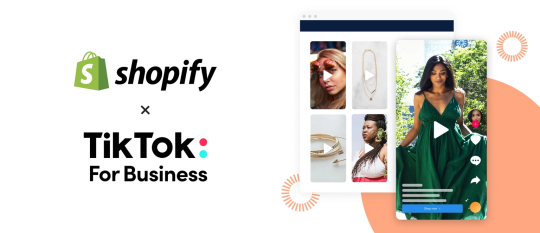
So what does this all mean? The most obvious answer is spending habits are changing, shopping is becoming much faster, easier and digitized. But there’s an underlying benefit to merchants (and possibly you) to a cashless, digital shopping experience? By integrating payments on an app, through social channels or what have you, payments companies and merchants now have a much stronger understanding of customer preferences, habits and interests with all of your payment history being collected digitally. With all of this data, merchants will be able to curate customized content and products for individual users, stores will be able to understand shopping trends better, and venues can have better insights on their fans purchasing habits in and out of the stadium. All of this may sound either really scary or really awesome. Gone could be the days of scrolling through websites to find that one shirt that speaks to you. Now, it’ll be the first sponsored post on your insta, click twice and in 2 days it’s at your doorstep for that party on Friday night. Creepy or cool? I’ll let you be the judge. Overall, do I think cash is going to be obsolete tomorrow? No and probably not for a long time. But I do believe this, recent events have dramatically shifted behaviors at a rate the world has never seen before (especially with financial decisions) and lowered barriers to entry for acceptance of our contactless world and we will be there much sooner than you think!
#IS6621
Sources:
https://techcrunch.com/2020/10/27/tiktok-invests-in-social-commerce-via-new-shopify-partnership/
https://www.nytimes.com/2020/07/06/business/cashless-transactions.html
https://www.forbes.com/sites/jiawertz/2020/08/01/3-emerging-e-commerce-growth-trends-to-leverage-in-2020/?sh=7a6890546fee
https://tappit.com/introducing-jags-pay/
7 notes
·
View notes
Text
Biometrics in Airports: Mostly Positive
The rise of biometrics over the last few years has been significant, and we are now at a place where we are going to be seeing implementations of this technology in our daily lives. Biometrics themselves are considered technology that is able to measure and calculate human characteristics. A popular implementation of biometric technology is for authentication purposes, such as your fingerprint or face being able to unlock your iPhone. However, the implementation that I will be talking about today is concerned with the mass use of biometrics in public places, such as airports.
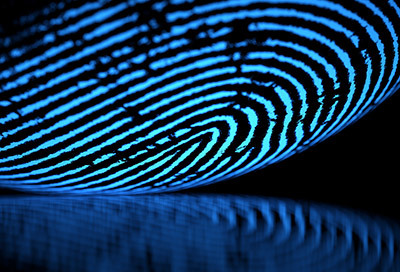
Airlines have already begun to experiment with this technology in multiple areas of their business. Delta has launched a “curb-to-gate” facial recognition system for international passengers at the Atlanta airport. This system will allow passengers to move quickly through the airport and reduce the amount of time that is normally spent waiting in security lines, checking their bags, and checking in for their flights. Additionally, this system and other biometric systems will allow for a greater level of security within airports which is undoubtedly a good thing for national security.
British Airways, who has implemented a similar system, reported that they are able to board 400 passengers in 22 minutes, which is less than half of the usual time it takes to board a plane that size. Delta has reported that its “curb-to-gate” system has decreased boarding times for wide-body planes by 9 minutes. Although a few minutes may not seem significant at first glance, it is important to note that saving a few minutes for each flight can translate to millions of dollars over the course of a year through thousands of flights.

Although these changes are clearly beneficial to both the consumers' time and the airline's bottom line, there are significant concerns surrounding the issue of privacy with this technology. Requiring travelers to use these systems in order to get on their flights will force everyone who ever travels by plane to forfeit their biometric profile to these companies and government agencies such as the TSA. Once a person’s biometric profile is in a system like that, there is really no knowing what it is going to be used for.
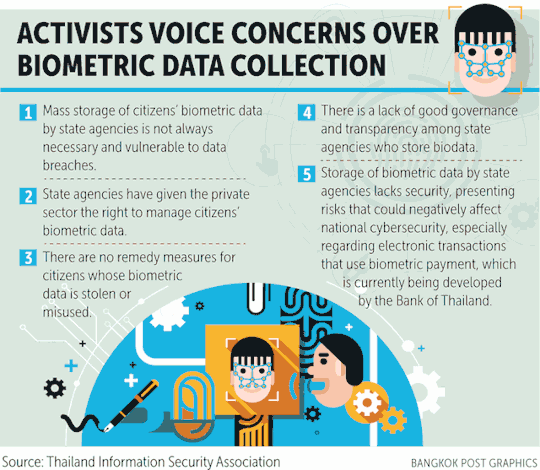
However, customers do not seem to mind very much. Delta reports that only 2% of their passengers choose to opt out of their facial recognition system and resort to the usual passport process. This is likely due to the increasing efficiency of the system, allowing for a significantly faster and easier process for the traveler. When the benefit increases, the concern for privacy becomes less and less important in relation to saving time and effort.
Biometrics are only being currently used for international travel, as there is only one federal database with all of the passport information. Because of this, it is very easy for biometric technology to check people’s faces against this one database. For domestic travel it is much more complex, as the most common form of identification is a state driver license. There are obviously more databases with slightly varying pictures and layout of information between each individual state. Because of this, we will likely have to wait a few years before biometric technology is able to benefit us for domestic flights. A domestic facial recognition system will likely start with travelers who are enrolled in TSA pre-check, as they are all required to have their pictures taken as a part of the application process, all of which are of course stored within the same database in a consistent manner.
Clear, a private firm, has taken the initiative and partnered with 27 airports to provide domestic biometric screening to people who desire to move quickly through security. Customers can sign up online and are required to pay a monthly fee of $15 for the service. It will be interesting to see if there is quicker growth on the private side of these systems or on the public side. My personal belief is that people who travel frequently will desire to use the Clear service, as it will be worth it to them as they are always traveling through airports.

In conclusion, biometric technology and facial recognition in airports will provide more positives through saving the time of the travelers than the negatives of potential privacy concerns. There will likely be a small percentage of the population who will simply refuse to become a part of the system, but will dwindle as the benefits of using this technology increase to a significant point.
Sources:
https://www.nbcnews.com/mach/science/biometric-screening-airports-spreading-fast-some-fear-face-scanning-systems-ncna982756
4 notes
·
View notes
Text
The Gap’s election day post is a reminder that, sometimes, it’s best for brands to stay silent – Jude Greenspan
This past Wednesday, as people across the US waited with baited breath to see the outcome of an increasingly tight election race, The Gap took to its social media channels to post a message of unity. The post, which was issued on both the brand’s Instagram and Twitter page, featured a half-red, half-blue hoodie along with the caption, “The one thing we know, is that together, we can move forward.” The post was met with resounding criticism and mockery from social media users across the political spectrum, who ridiculed the company for glossing over political divides for the sake of marketing its brand.

By mid-day, The Gap had deleted the post amid a bombardment of criticism. But it was too late – the post had already gone viral, with prominent figures like Chrissy Teigen as well as many others mocking the post. A cascade of media articles from top tier outlets like the New York Times also further publicized the company’s misstep. Much of the criticism centered both on the tone deaf nature of the post as well as the fact that The Gap was tweeting about politics at all. Some users drew comparisons to Pepsi’s 2017 commercial featuring Kendall Jenner among protesters - which was criticized at the time for co-opting imagery from protests to sell its product, while trivializing the actual issues that were being protested at the time in response to current events in the US.

In addition to deleting the post, a representative for the company released a statement further explaining the post and admitting, “it was just too soon for this message” but that The Gap remains “optimistic that our country will come together to drive positive change for all.”
The backlash over The Gap’s post is a reminder of the broader environment that brands need to navigate when developing any social media content. In the last few years, consumers and employees have been pushing companies to take a stand on more social and political issues. We saw evidence of this phenomenon this past summer, when multiple leading corporations took to their social channels to show solidarity with the Black Lives Matter movement. At the same time, a handful of recent missteps have demonstrated that there’s a balance between when and how to brands should respond to social issues vs. when brands should “go dark” and not post anything at all. The backlash over The Gap’s post is further evidence of just how delicate that balance is.

In my opinion, the post wasn’t controversial for promoting a specific political message – but rather for its lack thereof. It seems like Gap was trying to be a part of a national conversation – but rather than actually taking any sort of stance, they chose to go with a post that they thought would appease both sides. As such, the comparisons to the Kendall Jenner Pepsi ad – which similarly conveyed political imagery without attaching itself to any specific cause – are fair. Further, the timing of Gap’s post made it even worse. This post was most likely planned for at least a few days or even weeks, and was something The Gap was going to post regardless of the results. The company’s decision to issue the post the morning after the election – at a time when it was becoming clear that the race was going to be tight and that President Trump was going to proclaim victory before results were called – made the outcome that much worse.

+++
References
https://www.fastcompany.com/90570549/this-oreo-ad-is-a-hopelessly-baby-brained-salute-to-civility-before-a-contentious-election
https://www.vulture.com/2020/11/gap-election-2020-hoodie-tweet.html
https://www.nytimes.com/2020/11/04/business/gap-red-blue-shirt.html
https://www.prdaily.com/the-gap-deletes-post-election-tweet-baby-shark-becomes-most-watched-youtube-video-and-snapchat-adds-follower-counts/
https://sproutsocial.com/insights/social-media-strategic-silence/
3 notes
·
View notes
Text
Podcasts on Spotify: Why are they so successful? Caitie Kim
I’ve recently joined the podcast bandwagon this semester: Personally, I like listening to them as background noise when I’m getting ready or doing assignments. After our discussion on content trends and how people are increasingly engaging with podcasts, I kind of felt like I fell for a marketing scheme. Am I really interested in podcasts or am I just listening to them because everyone else is?

Over the past decade, podcasts have seen a steady rise in popularity, where 75% of Americans are familiar with podcasts and more than 50% have listened to a podcast themselves. Podcasts coincide with a general increase in digital media consumption, especially on mobile devices, as well as the fact that podcasts are increasingly accessible. Covering politics to sports, companies are embracing podcasts as a way to reach an engaged audience with strategically decided content. Anya Grundmann, NPR's senior vice president of programming, states that “podcasting is more and more the way people are spending time, trying to educate themselves, trying to get smarter, trying to have companionship in a moment when people are alone.”
COVID-19 has had mixed effects on the podcast industry, as most people listen to podcasts when they are commuting or at the gym. However, the lockdown forced everyone to stay inside. Yet, U.S. weekly podcast downloads were up 20% in April 2020, where categories such as news saw a 57% increase. Unsurprisingly, mental wellness podcasts gained a surge in popularity. That being said, companies are using podcasts as an opportunity to shift quickly and follow what is trending in the market.
Spotify has successfully built out its podcast business by tapping into a growing hunger for entertainment and news. That being said, Spotify survived the pandemic as its services are provided virtually. Following social distancing restrictions, Spotify show hosts have been able to record in the comfort of their own home, contributing to more than 700,000 podcast titles available on the platform. As Spotify’s podcast business continues to grow, the amount of podcast content consumed by monthly subscribers have nearly doubled. With that being said, Spotify made huge investments, rolling out support for video podcasts and featuring renowned people like Michelle Obama and Joe Rogan.

With increasingly sophisticated data collection, Spotify is able to recommend podcasts that capitative its users around a particular mood or moment in time. Spotify highlighted some podcast trends that they’ve found throughout the pandemic. With fewer people streaming from their cars during their daily commutes and increase in working from home, more people are streaming across computer desktops, TVs, and smart speakers. There has also been an increase in cooking/housework-themed podcasts, showing that people are primarily focusing on family and domestic tasks. Self-improvement podcasts are seeing increasing popularity as well.
However, how has Spotify competed against Apple? Though Apple has long been the dominant player in podcast consumption, Spotify is rising in popularity among listeners. In fact, Spotify is "ahead” in more than 60 markets: Spotify pointed to data tracked by podcast technology firm Voxnest, showing that between January and May, Spotify's podcasts were used more frequently than Apple podcasts in countries including Canada, Germany, France, Mexico and Spain. I found that Spotify’s success in the podcast industry was driven by two major factors.
1) Spotify has been successful at capturing podcast listening.
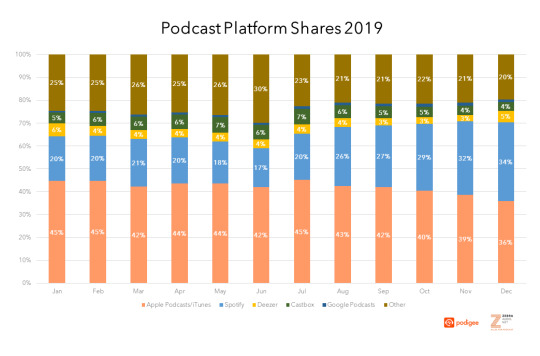
From January 2019 to December 2019, Spotify has quickly captured podcast platform shares. Spotify is growing because it was able to solve that discovery problem for some people. That being said, Spotify is not necessarily “stealing” Apple listeners. However, Spotify is presenting their regular music listeners with interesting podcasts right in the app they’re already using every day. This leads me to the second factor.
2) Spotify is incentivized to promote podcasts that keep its users happy.


Spotify’s business model depends on people using it as a streaming service. Therefore, anything that makes someone want to stop using Spotify is obviously a bad thing. This is where data driven recommendations become so important. Spotify listeners are primarily looking for entertainment, where Comedy and Sports podcasts are the most popular categories on the platform. That being said, Spotify invested huge amounts into developing an algorithm that matches podcasts (and advertisements for those who do not pay) to certain demographics that may be interested. In fact, I launched Spotify and went to the podcasts section. The top recommendation? A daily horoscope podcast.
Sources:
https://newsroom.spotify.com/2020-03-30/how-social-distancing-has-shifted-spotify-streaming/
https://www.latimes.com/entertainment-arts/business/story/2020-04-27/coronavirus-podcasts-spotify-finnea
https://www.theverge.com/2020/7/29/21346339/spotify-q2-2020-earnings-podcasts-coronavirus-covid-19-consumption-recovery
https://www.cnn.com/2020/06/15/media/spotify-podcasts-risk-takers/index.html
https://www.statista.com/chart/10713/podcast-listeners-in-the-united-states/
https://www.niemanlab.org/2020/02/spotify-is-gaining-a-podcast-audience-quickly-but-it-is-an-audience-that-isnt-as-interested-in-news/
5 notes
·
View notes





